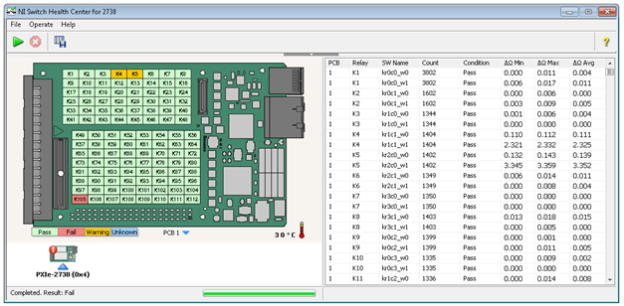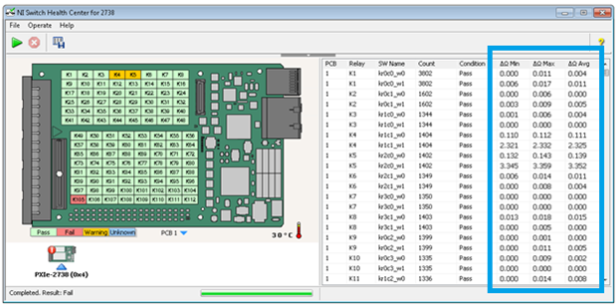Solution
Switch Health Center
Several NI Switch matrix modules released in 2015 and later now have access to the NI Switch Health Center. This was previously available only for NI SwitchBlock. The Switch Health Center allows users to monitor relay health and failure modes. Through software, a user can check if a relay is stuck closed (shorted) or stuck open, and can export this report with relay health and lifetime.

As of September 2017, this feature is supported by the following modules:
- PXIe-2737 - 4x64 2-Wire Matrix
- PXIe-2738 - 8x32 2-Wire Matrix
- PXIe-2739 - 16x16 2-Wire Matrix
- All NI SwitchBlock modules.
A list of all available SwitchBlock modules can be found below at
Matrix Modules for SwitchBlock.
Resistive Self-TestAs a part of the Switch Health Center, the new NI Switch matrix modules also include a Resistive Self-Test. This feature is not supported by SwitchBlock modules, but is currently supported by the following modules:
- PXIe-2737 - 4x64 2-Wire Matrix
- PXIe-2738 - 8x32 2-Wire Matrix
- PXIe-2739 - 16x16 2-Wire Matrix
When relays approach end-of-life, they will have increasing (or dramatically changing) levels of resistance across their paths. With Resistive Self-Test, users can now monitor the path resistance across each relay without connecting any external measurement devices. Not available on pre-2015 modules, this allows users to predict when relays are reaching end-of-life, and replace relays before they fail.

Highlighted in blue, resistance information includes the minimum and maximum resistance changes observed over a set of measurements, as well as the average difference. These differences are the change in resistance relative to a baseline resistance measured at the time the device was manufactured.
If the average difference is high, or if there is a large disparity between the minimum and maximum difference, it can indicate that relays are nearing end-of-life. Further information about this feature can be found in the NI Switches Help, installed with NI-SWITCH 15.1 or later.
On-Module Temperature Sensors The PXIe-2737, PXIe-2738, and PXIe-2739 (and the PXI-2542, PXI-2543, and PXI-2544 modules) include on-module temperature sensors. Temperature readings can be accessed from the NI Switch property node within LabVIEW, as seen below. Because temperature can impact resistance levels and data readings, monitoring temperature allows users to better understand and account for their testing conditions.
